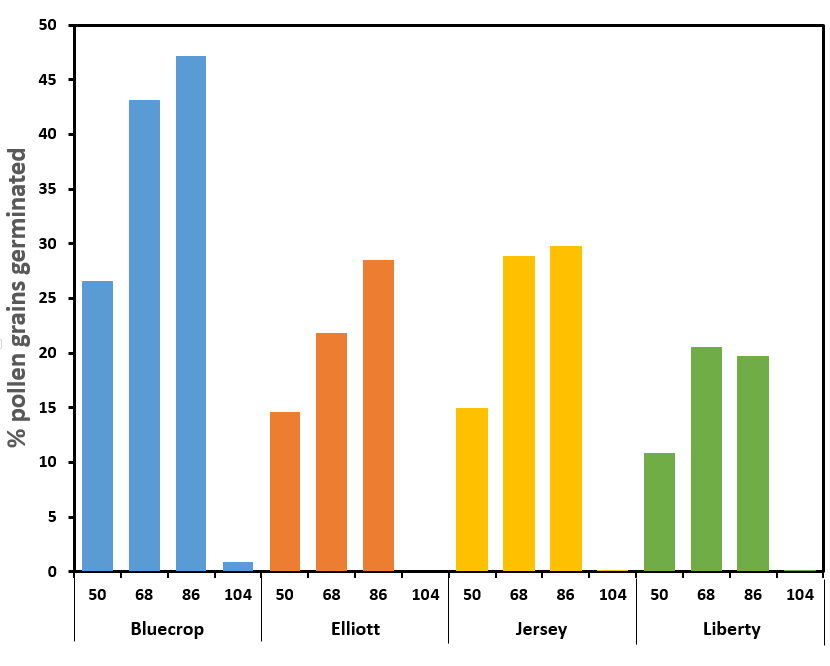May 24, 2019Effects of extreme heat on blueberry pollination
During the 2018 growing season, Michigan experienced an unprecedented heat-wave on Memorial Day weekend, in late May (Figure 1). Weather stations in west Michigan reported hours-long conditions above 90 degrees Fahrenheit over that weekend. Additionally, the winds were from the east, preventing the usual lake effect cooling in the region with most blueberries. This hot weather in late May overlapped with bloom of multiple blueberry cultivars. Overall, there was a much lower yield than in recent years, resulting in lots of questions on what could have caused this.
Growers reported some different cultivars being affected, with the level of damage depending on where the fields were located in relation to Lake Michigan and which county they were in. Based on this 2018 heatwave experience, we have spent some time this past winter exploring how high heat affects blueberry pollination. While we hope this information is never needed, if there are future heatwaves during bloom we should be better prepared next time.
Pollination is a complicated process with a lot of steps, and in most years this proceeds without problems. If all steps happen as expected, there should be high levels of fruit set and the berries will swell to large juicy fruit to harvest in summer. To reach this yield potential, growers need 1) healthy plants, 2) fields with sufficient bees, and 3) good weather conditions during bloom. Assuming most growers are following good horticultural practices and also renting sufficient honey bees for their fields (see 2016 article “Invest in pollination for success with highbush blueberries”), weather conditions can be a significant factor in how much yield comes from the bushes. There are decades of experience managing freeze conditions during bloom and we sometimes get cool weather during bloom that inhibits bee flight, but excessive heat was a new situation in 2018. In this article, we report what we have learned so far, and how growers can prepare for the next time we see hot weather during pollination season.
Effects of heat on pollen germination
With funding from the Michigan Blueberry Commission, we have started research to determine the effect of high heat conditions on blueberry pollination. We collected pollen from potted bushes of four common cultivars grown in a greenhouse, and then exposed the pollen to four different temperatures (50, 68, 86, and 104 F for up to five days). The graph shown in Figure 2 shows our first set of results from this research, showing the percent (%) of pollen grains that germinated at each temperature to form viable pollen tubes.
For all four cultivars we tested, pollen formation increased with temperature from 50 to 86 F, and reached a maximum of nearly 50% for Bluecrop pollen at 86 F. The germination rate of Bluecrop was much higher than the other cultivars. Above 86 F, we found very little pollen tube emergence in any of the cultivars, with only a tiny amount seen in Bluecrop. For all the other cultivars, there was zero pollen tube growth at this high temperature.


These results give us some guidance on the ideal range of temperature for blueberry pollen to grow, which is essential for fertilization of the ovaries, and show that somewhere between 86 and 104 F a threshold is exceeded and this process breaks down. We are continuing this work to get a more precise determination of this threshold. Still, it is clear that very hot temperatures can inhibit blueberry pollen growth. Documenting this is one thing, but what can a grower do about this?
Cooling bushes during bloom
Because heatwaves are so uncommon in Michigan in May, we don’t have much experience cooling bushes at this time of the season. Research by graduate student Joy Yang in David Bryla’s group at Oregon State University has shown that a microsprinkler system applied in summer to ripening berries reduced bush temperatures by 15-20 F. If the same temperature reduction is possible with the overhead sprinkler systems typically installed in Michigan fields, it would be worth running those during heatwave conditions to maintain pollen viability and preserve pollination. They misted for only 15 minutes per hour in the hottest part of the day, allowing the water to evaporate in between (cooling the field), so we would suggest triggering irrigation-based cooling at 90 F to ensure flowers don’t reach the critical temperature.
While bloom-time irrigation might make growers concerned about disease problems, reduced bee activity, or wet fields for tractor access, it is worth considering this “pollination protection” strategy if we ever face another hot spring. We will continue to explore this topic in our research, to understand more about the negative effects of heatwaves on the whole blueberry pollination process and to learn how to protect the fertilization process form extreme heat. If we do get a hot weather spell during bloom, we will be calling on some growers to test out using overhead irrigation for cooling, to test how effective this can be to ensure your flowers turn into harvestable berries.
– Rufus Isaacs, Jenna Walters, and Jacquelyn Albert, Michigan State University Department of Entomology
Figure 1 at top. Temperature forecast for Memorial Day 2018. Note the cooling effect of the easterly winds on the eastern side of the state and near Chicago.















